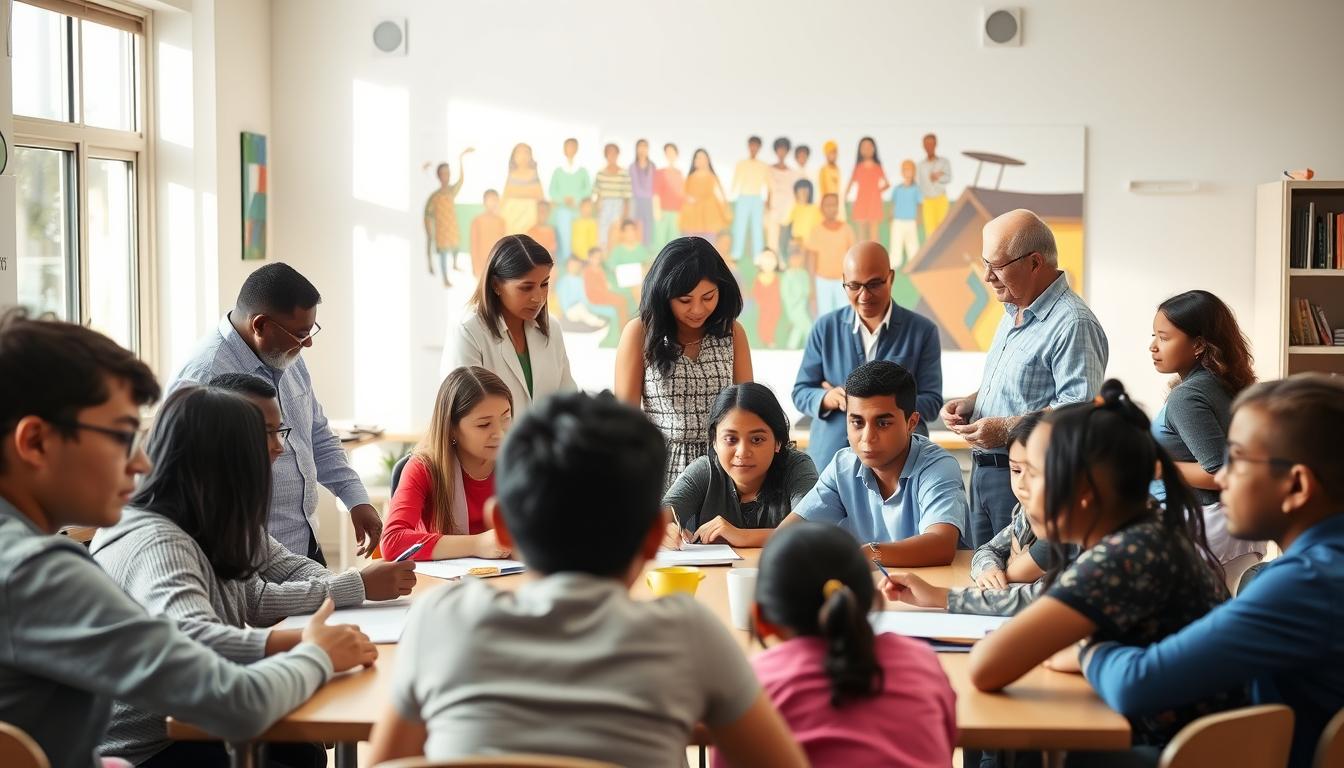Building a Better Future: The Role of Community Centers in Immigrant Education
In the United States, community centers are key in helping immigrants. They are places where people from different backgrounds can find help. These centers offer important services like language classes and job training.
They help newcomers adjust to their new home. This support is crucial for families starting over in a new place.
This article will look at how community centers help immigrants. We’ll see how they aid in cultural integration and support newcomers.
Understanding the Importance of Community Centers
Community centers are key for immigrants adjusting to new places. They offer many services to help people connect and integrate. These services improve immigrants’ lives through activities that are social, educational, and fun.
Definition and Functions of Community Centers
Community centers are places with lots of resources for the community. They have:
- Language instruction and tutoring
- Cultural exchange programs
- Social events and recreational opportunities
- Access to legal and healthcare services
- Job training and vocational programs
These services help immigrants settle into their new homes. They make sure immigrants have what they need to succeed.
Historical Context of Community Centers in the U.S.
Community centers in the U.S. started in the early 1900s. They were for immigrants back then. Now, they offer important services for different people.
They have helped immigrants for a long time. This shows their importance in helping people grow strong and confident.
The Need for Immigrant Education
Immigrants in the United States face many challenges. These include economic struggles, cultural differences, and language barriers. Many immigrants have limited English skills, making it hard to find jobs, get healthcare, and join community activities.
Effective education is key to overcoming these obstacles. Programs that help with language and culture are especially important.
Challenges Faced by Immigrants in the U.S.
Immigrants deal with several big issues:
- Economic hardships: Many struggle to find jobs that fit their skills.
- Language barriers: Not speaking English well limits talking in work and life.
- Cultural misunderstandings: Adapting to a new culture can make people feel alone and upset.
The Impact of Language and Cultural Barriers
Language and cultural barriers can hold people back. For immigrants, learning English is crucial for success. Cultural programs help connect different communities.
Community centers offer vital education. They help immigrants overcome these barriers. This way, they can fully join American society.
Services Offered by Community Centers for Immigrant Education
Community centers are key in helping immigrants learn and grow. They offer many services to meet the needs of this group. These include programs to improve language skills and prepare for jobs.
Language Classes and Literacy Programs
Learning a new language is essential for immigrants to fit in. Community centers have English classes and literacy programs for all levels. People see big improvements in their speaking and reading, boosting their confidence.
These programs help with everyday talk, work, and even getting a U.S. citizenship.
Vocational Training and Career Counseling
Community centers also focus on vocational training for immigrants. They teach skills needed in fields like healthcare, construction, and tech. This training is crucial for getting a job.
Career counseling helps immigrants find jobs. They get advice on resumes, interviews, and job hunting. This support is key for a smooth transition into the workforce.
Building Community Through Inclusion
Community centers are key in making everyone feel welcome. They offer programs that help newcomers feel at home. These programs also bring people from different backgrounds together.
Through activities, community outreach helps bridge cultural gaps. This makes everyone feel included.
Fostering a Sense of Belonging
Community centers host events like cultural gatherings and meals. These events help people from different backgrounds connect. It helps them feel less alone.
By sharing experiences, people build friendships. This sense of belonging boosts mental health and helps them face challenges.
Promoting Cultural Exchange and Understanding
Community centers showcase the diversity of cultures. Workshops and art exhibitions let people share their heritage. They also learn about others.
This exchange breaks down stereotypes and builds empathy. It enriches individual experiences and strengthens community bonds. This leads to better education and a more united society.
Partnerships with Local Organizations
Community centers are key in helping immigrants learn through partnerships with local groups. Working together with schools, universities, and nonprofits helps meet educational needs. This teamwork makes resources more available, helping immigrants get the support they need.
Collaborations with Schools and Universities
Working with schools and universities brings together knowledge and resources. Community centers get access to skilled teachers and learning materials. This helps immigrant families a lot.
Some programs include:
- Joint workshops focused on language acquisition
- Community events that spotlight cultural diversity
- Research initiatives that provide valuable insights into immigrant educational challenges
Role of Nonprofits in Supporting Immigrant Education
Nonprofits play a big role in supporting immigrant education. They have strong ties with immigrant communities. This makes them great partners for outreach efforts.
- Providing financial assistance and scholarships for educational programs
- Offering volunteer services to support tutoring and mentoring
- Creating networking opportunities that connect immigrants with job resources
Funding and Resources for Community Centers
Funding is key for community centers to help immigrant families. It supports their educational programs. This lets these centers grow and help their communities. We’ll look at grants and donations that help these centers stay strong.
Federal and State Grants for Educational Programs
Grants from the federal and state governments help a lot. They fund educational programs for immigrants. This money helps with things like language classes and vocational training.
Community Donations and Fundraising Initiatives
Donations from the community and fundraising help too. Local people and businesses give money to help out. Events like bake sales and charity runs bring in funds and build community spirit.
Case Studies of Successful Community Centers
Across the United States, many community centers have made a big difference. They offer support services for immigrants and create education programs that fit diverse needs. These centers have found ways to engage their communities through programs that are culturally relevant. Here are some examples of their innovative strategies and the good results they’ve seen.
Examples of Effective Programs Nationwide
Community centers have set up a wide range of programs to improve education for immigrants. Here are a few examples:
- La Comunidad Hispana in Pennsylvania offers ESL classes and job readiness workshops. They focus on what the local job market needs.
- Asian American Community Services in Ohio has programs like citizenship preparation and community engagement. They make sure education is relevant to the community.
- International Institute of St. Louis provides a range of support services. They help with legal issues and health resources, making it easier for immigrants to settle in.
Lessons Learned from Implementing Immigrant Education
The success of these centers teaches us important lessons for future programs:
- Working with community leaders builds trust and gets more people involved in programs.
- Adding cultural elements to education makes it more relevant for everyone.
- Being flexible with programs helps centers meet changing needs of immigrant communities.
Strategies for Enhancing Immigrant Education
Community centers are key in helping immigrant students. They offer special programs and use technology to improve learning. This helps students get better results in their studies.
Tailoring Programs to Meet Specific Needs
Community centers know how to help different immigrant groups. They make special programs for each group. Here are some ways they do it:
- They find out what each group needs to learn.
- They offer classes at times that work for everyone’s busy lives.
- They make sure their programs respect each culture.
Utilizing Technology in Educational Initiatives
Technology makes learning fun and easy for immigrants. Community centers use digital tools to make learning better. Here are some ways they use technology:
- They use online language classes that students can do at their own pace.
- They have virtual classrooms where students can learn from teachers anywhere.
- They provide multimedia resources to make learning more interesting.
Advocacy for Immigrant Rights and Education
Community centers are key in fighting for immigrant education and rights. They mix education with advocacy to change policies that affect immigrants. This work helps individuals and brings about big changes, showing the power of community in policy.
The Role of Community Centers in Policy Change
Community centers are vital in making policies better for immigrant education. They create programs to tackle immigrant challenges. They also talk to local leaders to make sure immigrant voices are heard.
This helps make education fairer and more accessible for everyone.
Engaging Immigrants in Advocacy Efforts
Helping immigrants speak up in advocacy is very important. Community centers offer training and tools for this. They hold workshops to teach immigrants about politics and how to fight for their rights.
This boosts confidence and creates a strong community spirit. Together, they can make real changes.
Measuring the Success of Immigrant Education Programs
Effective immigrant education programs use different ways to check if they work well. They look at how well participants do and how the community changes. By using both numbers and stories, community centers can really understand the impact of these programs.
Assessing Outcomes and Impact on Communities
Success indicators for immigrant programs show how well educational efforts are doing. They might look at things like:
- How well people improve their language skills
- How many jobs people get after vocational training
- How much more people get involved in the community
Community centers can use these signs to see what’s working and what needs work. This helps keep their programs effective and meaningful.
Surveys and Feedback from Participants
Getting feedback from participants is key to understanding the impact of education. Surveys help find out if people are happy and what could be better. They often talk about things like:
- How good the teaching and materials are
- How easy it is to get to resources
- How well the programs meet individual needs
This feedback helps improve educational services. It makes sure they better meet the needs of immigrant communities.
Future Trends in Immigrant Education
Community centers are key in shaping the future of immigrant education. They help meet the changing needs of immigrants. By understanding these trends, we can create better educational programs for them.
Evolving Needs of Immigrant Populations
Today, immigrants face new challenges that need special educational solutions. These include:
- The need for digital skills as technology is now crucial in education and work.
- Language learning that fits different dialects and learning ways.
- Support for mental health and well-being as immigrants adjust to new places.
The Role of Community Centers in Adapting to Change
Community centers are essential in meeting immigrant education needs. They work on:
- Team-ups with tech firms to improve digital skills training.
- Flexible programs for all ages, especially older immigrants.
- Outreach to engage immigrant families in learning, making resources available.
Conclusion: The Vital Role of Community Centers
Community centers are key for immigrants, offering vital support and resources. They help immigrants fit into society by addressing language and cultural barriers. These centers provide education and a welcoming space for everyone.
Investing in community centers is crucial. It helps them meet the changing needs of immigrant families. This ensures they can keep supporting and empowering immigrants.
Community centers do more than just educate. They bring people together, promoting cultural exchange and support. By growing and adapting, they become stronger, helping to build a united community.
To keep community centers effective, we need to support them with policies and funding. This ensures they can continue to offer inclusive education. By working together, we can make our communities better for everyone.
FAQ
What services do community centers provide for immigrants?
How can immigrants find language classes in their community?
Are there specific programs for immigrant youth?
How do community centers foster cultural integration?
What are the challenges immigrants face that community centers help address?
How do partnerships enhance the services provided by community centers?
What role does advocacy play in immigrant education?
How can the success of immigrant education programs be measured?
What future trends are emerging in immigrant education?
Published on: 28 de February de 2025

Luke Martin
Luke Martin, author of Credwallets.com, is a mathematics graduate with a specialization in financial markets. Known for his love of pets and his passion for sharing knowledge, Luke created the site to provide valuable insights into the complexities of the financial world. His approachable style and dedication to helping others make informed financial decisions make his work accessible to all, whether they're new to finance or seasoned investors.







